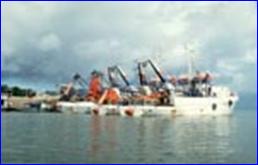Shrimp Fishing
The main fishing fleet is Spanish, with big shrimps (gambas) amounting 50% of the overall shrimps and crustaceans catch.
However, recent figures show that shrimp catches represent only 16% of total catches of shrimp trawlers, when unfortunately the by-catch (fausse pêche) rate is of 85%, despite the fact that Mauritanian legislation allows a maximum by-catch of 35%.
National and European shrimp trawlers throw the vast majority of this by-catch back into the sea.

In 2004, in the framework of a previous EU – Mauritania agreement, 37 of the 70 shrimp trawlers operating in Mauritanian waters were originated from the EU. This fleet caught mainly coastal and deep sea shrimp, with landings of about 4,000 tons/year. Current regulations are allowing the EU shrimp boats to use a smaller mesh size of 50 mm for their nets, compared to the one used by Mauritanian boats. Coastal shrimp was considered as being fully exploited in 2004.
In terms of sustainable development, current shrimp trawl fishing has a seroius impact on the ecosystem. In the long term, an overexploitation of crustaceans might have catastrophic repercussions on the viability of demersal fishing in Mauritania because it induces the disappearance of a major link in the trophical milieu.
The new EU Mauritania agreement stipulates that the two parties will carry out technical tests in order to defining selectivity mechanisms to reduce by-catch, notably by way of selectivity grids for trawl nets and the use of selective equipment, other than trawl nets as such.
Shrimp commercial fishing belong to the “special fishing” category and calls for a dedicated license.


 - °
- °

